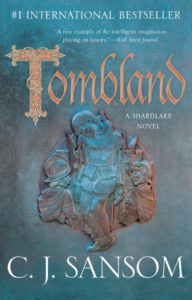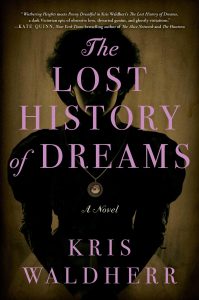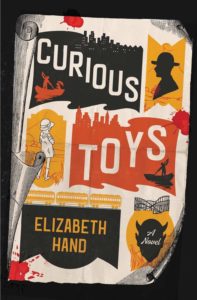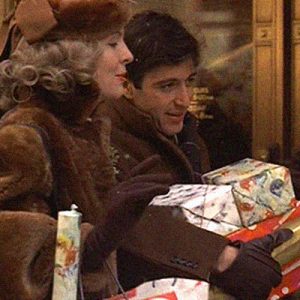Historical fiction may just be the broadest category of crime writing—after all, any novel set beyond living memory that requires research into the past counts as historical, and that’s quite a lot of works. Historical fiction is particularly complementary to the murder mystery; lending plausibility to high death counts and grounding the context of the story in details that are far enough removed from our own environment as to be a more nuanced portrait. We are trapped in our own selves when it comes to understanding the present, and we need the Archimedean Point of history for a clear-eyed view of humanity in all its glory and shame.
This year’s historical crime picks run the gamut from medieval to mid-20th century, featuring revolutionary fervor, enlightenment woes, gothic romance, and (as must be inevitable now that the decade is about to turn) lots of crime in the 1920s. Thanks to Olivia Rutigliano for recommending Curious Toys; the rest of the blurbs are my own. As with any list, this reflects my personal taste; there were so many wonderful historical crime novels that came out this year, and you’ll find a list of notables at the bottom of the post.
C.J. Sansom, Tombland (Mulholland)
London, 1549
The year is 1549, Henry VIII is recently deceased, and England is stewing in chaos. In the latest of C.J. Sansom’s Tudor-era mystery series, his enlightened detective, a lawyer working for young Queen Elizabeth (as yet to be crowned) journeys to a remote estate to investigate the death of one of his employer’s distant relatives, a political killing bound to stoke the flames of a kingdom in upheaval. You can read an exclusive excerpt here.
Niklas Nat och Dag, The Wolf and the Watchman (Atria)
Stockholm, 1793
From a scion of Sweden’s oldest living noble family comes a saga of blood, vengeance, and reckonings. Set in 793, at a time of massive political upheaval and fear of revolution across the continent, The Wolf and the Watchman begins with a gruesome discovery: a torso washes up on the edge of a sewage pond, showing evidence of sustained cruelty and the slow removal of each missing body part. A one-armed veteran employed as a watchman is determined to discover the nameless corpse’s identity, and track down the killer, but even a man as worldly as he is unprepared for the sordid tale that awaits.
Alix Nathan, The Warlow Experiment (Doubleday)
Wales, 1793
This enlightenment thriller brings together many of my favorite tropes: the folly of wealth, dilettante intellectuals, and sudden power reversals. In the late 18th century, a frustrated aristocrat embarks on a project bound to earn him acclaim from his peers—he will hire a man to live underground for seven years, in order to study the effects of isolation on the human psyche. While he sets up a veritable basement palace, the only man willing to take the job is Warlow, a barely literate farmer with a large family to feed. Warlow quickly loses his sanity when confronted with utter loneliness, even as the scientist finds himself increasingly attracted to Warlow’s wife, for what becomes a fascinating meditation on power, intellect, and revenge.
Sara Collins, Confessions of Frannie Langton (Harper)
Georgian England & Caribbean
Sara Collins’ brilliant psychological thriller of cultural appropriation and forbidden love is utterly fascinating. Told as a confession from Frannie Langton, imprisoned for the murder of her employer-turned-lover, the novel begins on a plantation, where the plantation owner, a wannabe scientist, spends his time appropriating knowledge from his West African slaves and repackaging it as his own discoveries. Frannie works as the master’s secretary, and strongly suspects herself to be his daughter, so she’s flummoxed when he takes her to England and dumps her at a friend’s house where she’s expected to be just a common servant. Her new employer is a hopeless boor, but his wife is an alluring English rose, and Frannie finds herself entangled in an uneasy triangle of intellect and romance soon enough torn asunder by murder.
Kris Waldherr, The Lost History of Dreams (Atria)
England, 1850
In The Lost History of Dreams, a Victorian death photographer long estranged from his family is recruited to take a last photograph of his famous poet cousin, a stand in for Lord Byron. He’s then tasked with taking the corpse to be buried alongside the poet’s long-dead wife on an estate run by a poor relation. The photographer soon discovers the residents of the estate have their own agendas, and their own complicated stories to tell. A richly detailed work that perfectly captures the artistic spirit of the era!
Elizabeth Hand, Curious Toys (Mulholland)
Chicago, 1915
From an author who has achieved acclaim for stories of crime, horror, and fantasy, comes a new tale of intrigue and murder that checks off many of my favorite boxes. It’s got: lady detectives, old seaside amusement parks, the Gilded Age, silent film, women who disguise as men to embed in male-only groups, women who look out for other women, obscure real-life artist and writer Henry Darger. I could continue, though I’ll reel in my excitement for the sake of finishing this blurb. In 1915, a fourteen-year-old girl, Pin, disguises as a boy to join a gang that roams around Chicago’s Riverview amusement park. She doesn’t know that she’s in a prime position to observe a serial killer who uses the park as his hunting ground—but when she sees a man bring a girl into the Hell Gate ride and leave alone, she knows something has gone wrong. And only Pin, the invisible girl detective, can catch an invisible killer.—OR
Abir Mukherjee, Smoke and Ashes (Pegasus)
Calcutta, 1921
Mukherjee’s strung-out detective protagonist, Captain Sam Wyndham, is already struggling to hide his shellshock-induced opium addiction from his superiors even before he comes across a body in an opium den with remarkable similarities to another recent murder. With his no-nonsense sidekick, Surrender-Not Bannerjee, Sam must track down a serial killer without letting his superiors catch on to any of his nighttime perambulations or drugged out misdeeds. Mukherjee excels at giving the traditional mystery structure a hard-boiled edge, and immersing the reader in a complex historical landscape of colonial decline and rising nationalism.
Lindsay Faye, The Paragon Hotel (Putnam)
Portland, 1921
The Paragon Hotel, set in the 1920s, follows a flapper and gangster moll on the run who washes up in Portland and ends up staying at—you guessed it—The Paragon Hotel, where all can find shelter, including much of Portland’s small African-American community. She finds herself torn between attractions to a sympathetic young man and an alluring and powerful woman, all while attempting to evade the attentions of her pursuers. Faye perfectly captures the slang of the 1920s, proving once again that she can write in whatever era she puts her mind to.
Sujata Massey, The Satapur Moonstone (Soho Press)
Satapur, 1922
Sujata Massey burst on the scene with 2017’s The Widows of Malabar, establishing herself as one of the most exciting new voices in historical fiction and leaving us begging for more adventures with her charming but tough protagonist, one of the few female lawyers in colonial India. Her 2019 follow-up, The Satapur Moonstone, takes us into the mountain kingdom of Satapur, where the royal family is in a tizzy over a family curse and the education of the royal scion. It’s up to Massey’s ever-practical heroine to wade into the foray.
Amanda Lee Koe, Delayed Rays of a Star (Nan Talese)
1920s-1970s
While this one isn’t strictly crime, its cast of leading ladies from the Golden Age of Hollywood casts a noir shadow long enough to include on this list. Delayed Rays of a Star takes us into the intersecting lives of Leni Riefenstahl, Marlene Dietrich, and Anna May Wong, and through the stories of these women, gives us a complex portrait of the century as a whole, as well as a timeless examination of the pressures and compromises of female fame. The book was inspired by a photograph of the three actresses together at a party in Berlin, long before politics, country, and prejudice would divide them forever.
___________________________________
Notable Selections
___________________________________
S.D. Sykes, The Bone Fire (Medieval) · Mary Lawrence, The Alchemist of Lost Souls (1544) · Elizabeth Fremantle, The Poison Bed (1644) · Elizabeth McNeal, The Doll Factory (1850s) · Oscar de Muriel, Loch of the Dead (1873) · Boris Akunin, The Coronation (1896) · Laura Purcell, The Poison Thread (Victorian Era) · Amy Stewart, Kopp Sisters on the March (1917) · L.A. Chandlar, The Pearl Dagger (1930s) · Phillip Kerr, Metropolis (WWII) · Kate Quinn, The Huntress (Aftermath of WWII) · Gary Phillips, The Be-Bop Barbarians (1950s) · Ji-Min Lee, The Spy and the Starlet (1950s)



























